Impact of Vertical Ground Accelerations on Nonstructural Components
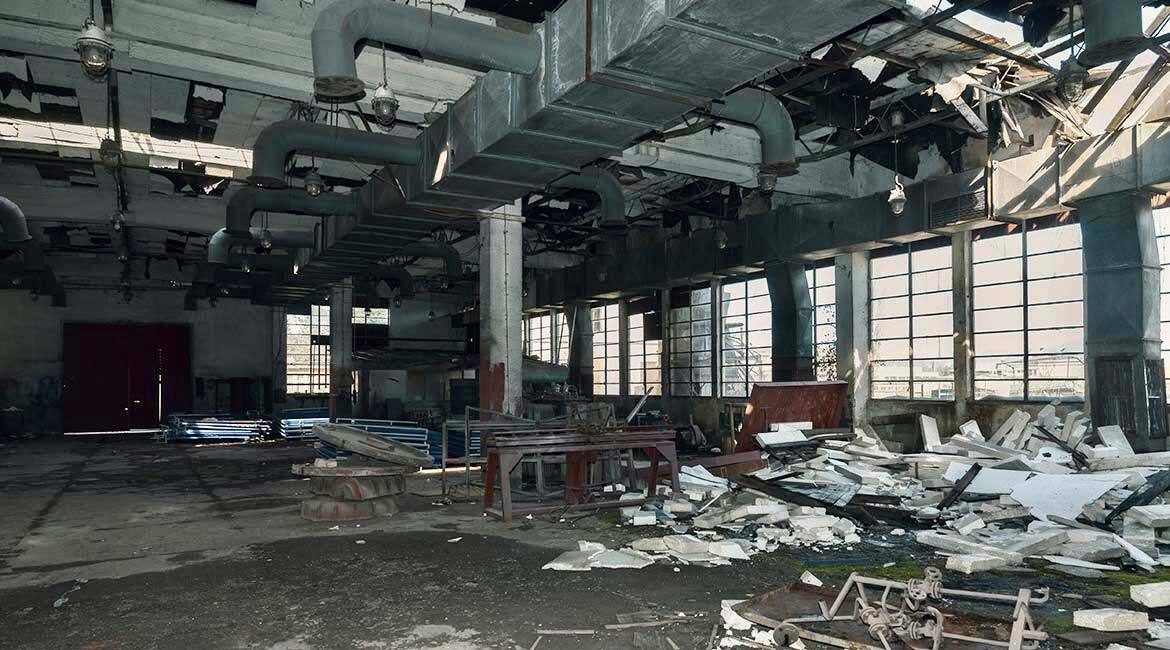
Purchased on Istockphoto.com. Copyright.
Over the past decades, many earthquakes, such as the 1994 Mw 6.7 Northridge earthquake, have caused failure and damage to nonstructural components (NSCs) due to the high vertical acceleration impact of ground motions. Yet the effects of vertical ground motions are generally neglected in seismic designs of typical structures, supposedly minor compared to the effects of horizontal ground motions, and the absence of provisions in the codes, especially NBC 2015, is highly noticeable. In this research, a profile of vertical acceleration design spectra (ADSver) was proposed for firm soils, known as Site Class C in Montreal, in the Eastern Canada seismic zone. In addition, the amplification of Vertical Peak Floor Acceleration in typical RC buildings was assessed. Keywords: Nonstructural components (NSCs), vertical ground motion, Vertical to Horizontal Acceleration Ratio (V/H), Vertical Acceleration Design Spectra (ADSV), Vertical Peak Floor Acceleration (PFAV).
Vertical Component of Ground Motion Demands on Nonstructural Components
Building elements that are not part of the lateral resisting systems or load-bearing elements are known as Nonstructural Components and Systems (NSCs). These systems are defined as Operational and Functional Components (OFCs) CSA S832 (CSA-S832, 2014). NSCs are classified into architectural components (external and internal), building services and utilities such as mechanical and electrical facilities, building contents, with common and specialized components such as elevator systems (CSA-S832, 2014). Figure 1 shows different types of NSCs, such as plumbing, electrical equipment, air conditioning systems, and suspended ceiling.
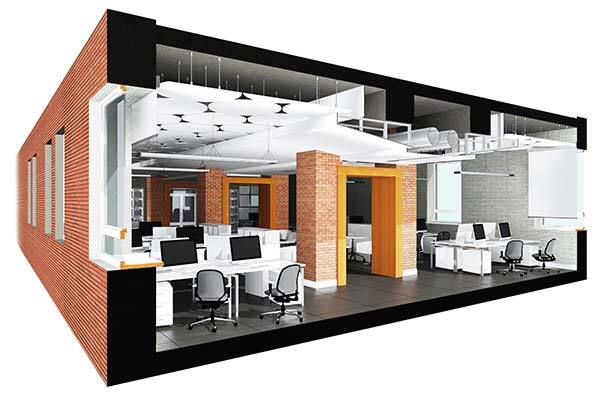
Figure 1. Nonstructural components of a typical building
The most significant portion of building costs is related to NSC costs, especially in major buildings like hospitals and museums. Therefore, NSC failures can lead to substantial financial losses and business interruptions. Figure 2 shows the economic contribution of structural and nonstructural components specified in three different building types (Taghavi & Miranda, 2003).
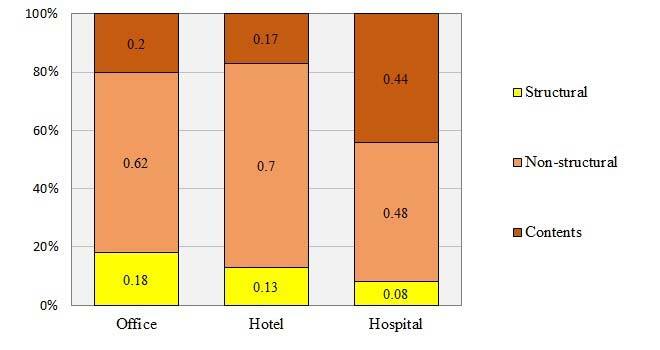
Figure 2. Relative component values for different building types (Taghavi & Miranda, 2003)
Vertical Seismic Design Spectra in Eastern Canada
Most codes and standards, such as ASCE/SEI 7-16 (ASCE/SEI 7-16, 2017) and Eurocode 8-1 (Eurocode 8-1, 2004), propose some relationships in developing a vertical seismic design acceleration spectra. However, the National Building Code of Canada (NBC, 2015) suggests obtaining the vertical acceleration design spectra by multiplying the available horizontal spectra by a constant empirical ratio equal to 2/3. However, according to previous studies—Bozorgnia et al. (1996); Ambraseys & Douglas (2003); Gülerce & Abrahamson (2011)—this prescribed ratio is overestimated for far-field areas and underestimated for near-field areas. Therefore, the vertical seismic force of NSCs in NBC 2015 is based on the codified constant V/H acceleration ratio, leading to an inaccurate evaluation of their response in the case of near-fault site conditions (Assi et al., 2017).
In this study, V/H pseudo-spectral acceleration (PSA) ratios were computed for 248 records from 67 historical earthquakes in the Eastern Canada region with a magnitude Mw ≥ 3.0 and an epicentral distance (Repi) < 150 km. The computed mean V/H PSA ratios exceeded the commonly used value of 2/3, especially at the short period range up to 1.0 sec. V/H PSA ratios of 0.86 for T ≤ 1.0 sec and 0.67, otherwise, were suggested for the Eastern Canada seismic region. Therefore, a vertical acceleration design spectra (ADSver) for Site Class C in Montreal corresponding to a 2475-year return period (2% probability of exceedance over 50 years), known as Sver(T), was proposed as illustrated in Figure 3. The horizontal and vertical spectra currently proposed by ASCE/SEI 7-16 and ASCE 41-17 provisions (SaM) and NBC 2015 are also shown in the Figure.
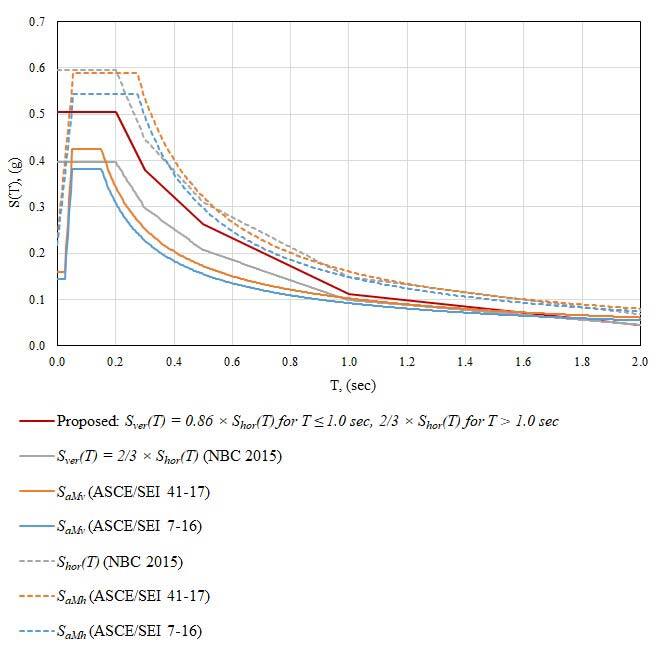
Figure 3. Proposed Sver(T) and calculated Vertical Acceleration Design Spectra (ADSver) based on ASCE/SEI 41-17, ASCE/SEI 7-16 (SaM), and NBC 2015 for Site Class C in Montreal
Vertical Peak Floor Acceleration (PFAV)
The Peak Floor Acceleration (PFA) demand on rigid NSCs due to the strong vertical seismic motion was evaluated in 3, 6, 9, and 12-storey reinforced concrete moment-resisting frame buildings with limited ductility designed according to the National Building Code of Canada (NBC 2015) shown in Figure 4.
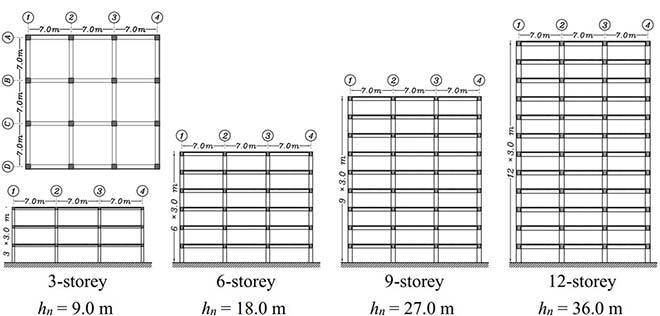
Figure 4. Plan and elevation views of the archetype RC moment-resisting frame buildings
In this regard, 65 sets of historical records from 31 severe earthquakes in the world were used to evaluate the amplification of vertical accelerations along the height and at the middle of beams (exterior and interior frames) and slab nodes (centre, corner, and side slabs) of different building floor levels. A constant noticeable normalized amplification of Vertical Peak Floor Acceleration (PFAV) was observed for slab nodes, as shown in Figure 5, especially at the centre of the interior slab, reaching the value of 6.0 for the 3-storey building. On the other hand, the normalized rooftop PFAH was assessed to emphasize how it differed from the normalized PFAV demand as a function of the building height. A median amplification of PFAH, equal to 1.40, was found for the rooftop of the 3-, 6-, 9-, and 12-storey buildings, respectively, indicating that the linearly increasing NBC 2015 profile resulting in an amplification of 3.0 at the rooftop is too conservative. The computed and proposed profiles with a maximum amplification equal to 2.0 at the roof are shown in Figure 6.
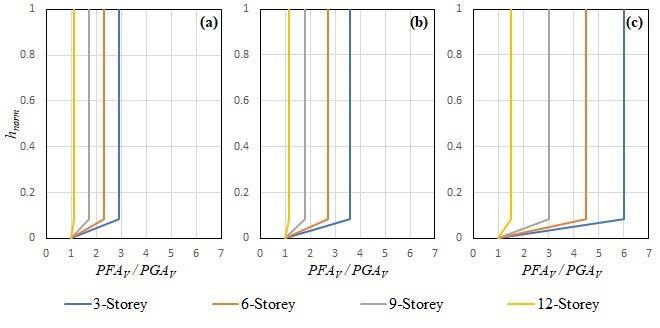
Figure 5. Amplification of normalized PFAV through building heights using the proposed equation of this study for the building archetype at the center of a) corner, b) side, c) interior slabs
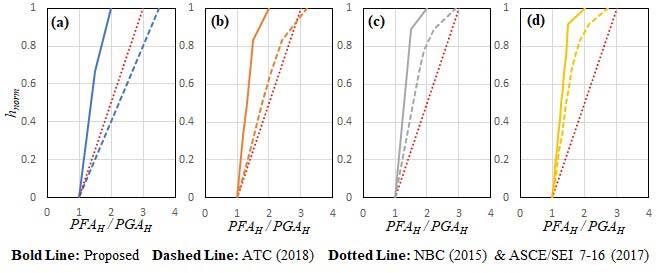
Figure 6. Amplification of normalized PFAH through the a) 3-storey, b) 6-storey, c) 9-storey, and d) 12-storey building heights using the proposed equation of this study versus codes
Conclusion
The calculated V/H ratios of acceleration design spectra exceeded the empirical ratio of 2/3, suggested in most codes, at all period ranges, spotlighting the importance of considering the vertical component of ground motions in the seismic analysis of nonstructural components located in the Eastern Canada region.
The computed vertical-to-horizontal Peak Floor Acceleration (PFAV/PFAH) ratios at the building rooftops exceed the empirical ratio of 2/3 proposed in NBC 2015 and decrease as building height increases. The results highlight the importance of modelling assumptions associated with the distribution of active seismic masses at floor levels since the amplification of vertical accelerations is closely linked to the location within the floor. Furthermore, results show that the normalized PFAV along the beam span or at the slab bay decreases as structure height increases. In this regard, the median normalized PFAV at the rooftop interior slab ranged from 4.45 for the 3-storey building to 1.24 for the 12-storey building.
Additional Information
For more information on this research, please refer to the following research papers:
Mazloom, S., & Assi, R. (2021). Assessment of Vertical Spectral Acceleration Demands in Eastern Canada Seismic Zone. Paper presented at the CSCE Annual Conference, Saskatoon.
Mazloom, S., & Assi, R. (2022a). Estimate of V/H Spectral Acceleration Ratios for Firm Soil Sites in Eastern Canada. Soil dynamics and earthquake engineering, 159, 107350.
Mazloom, S., & Assi, R. (2022b). Estimation of the Vertical Peak Floor Acceleration Demands in Linear Elastic RC Moment-Resisting Frame Buildings. Journal of Earthquake Engineering, 1-33.



